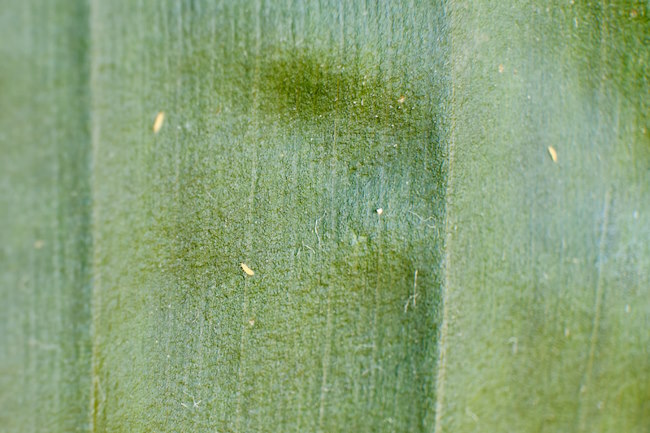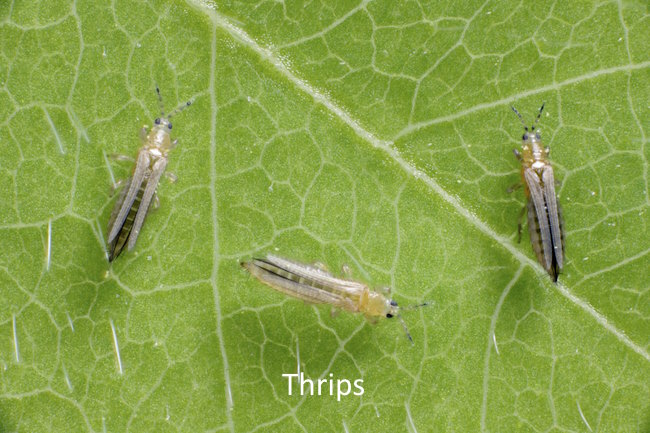Get Rid of Thrips on Houseplants
Find out all you need to know to get rid of thrips on houseplants. Here, you'll discover how to identify thrips, the damage they do, and learn the best ways to control these troublesome insects indoors.
Fortunately, these microscopic pests are not common on indoor plants. They're more typically found in the outdoor flower garden, however they can hitch a ride indoors on plants, people and pets. Once inside, thrips have no choice but to feed on your houseplants.
What Thrips Look Like
Adult thrips are thin, black insects with translucent, fringed wings. They have 6 legs and antennae. Belonging to the order Thysanoptera, they include many species that are difficult to tell apart.
They're tiny -- not more than 1/16-inch (.16cm) -- and difficult to see unless disturbed. Thrips can crawl and hop, but can only fly a short distance, perhaps from leaf to leaf. With a strong magnifying glass, you may be able to see dark slivers with feathery wings on the biggest thrips.
Young thrips (called larvae) are yellowish and wingless.
 Macro lens image of thrip larvae on a houseplant leaf. Image © Andrey Zhuravlev
Macro lens image of thrip larvae on a houseplant leaf. Image © Andrey ZhuravlevLife Cycle of a Thrip
The thrip life cycle begins with the egg stage, followed by larvae stage (also called nymph), then adult stage.
Thrip insects multiply quickly. Female thrips can lay dozens of eggs at a time. The whole life cycle can complete in a few weeks so it doesn't take long before you have a large infestation on your hands. To get rid of thrips on houseplants, you need to kill them at every stage.
Where to Find Thrips on Houseplants
Thrip insects suck plant juices with their needle-sharp mouthparts, causing a great deal of damage to plants. They feed on leaves, stems, and flowers. Look on the undersides of leaves too, where they may hide.
Females can lay hundreds of eggs in their short lifetime, inserting them into plant tissue. As eggs grow into the larvae stage, they begin feeding on plants.
Thrip larvae is sometimes found on the surface of the soil, so be sure to treat the soil, too.
It's a good idea to check your houseplants for signs of insects every time you water them. Thrips reproduce several times a year and with a large population, will do a lot of damage. Treat any infestation as soon as you notice it.
Damage of Thrips
Obvious signs of an infestation are silvery streaked areas on stems and leaves. Young leaves may pucker or curl where the thrips have fed on them.
Thrips attack flowers, too. These microscopic insects will bore into the bottoms of the flowers and suck plant juices from the petals. Brown spots or blotches on petals, distorted buds or blooms, and scattered pollen are tell-tale signs of thrip damage.
 Magnified image of adult thrips on leaf. Image credit ©Tomasz Klejdysz
Magnified image of adult thrips on leaf. Image credit ©Tomasz KlejdyszHow to Prevent Thrips on Your Indoor Plants
- Look over any plant before you buy it. You don't want to bring thrips home with you. Check for mottled or silvery streaked foliage, dusty black droppings, or distorted young leaves or flowers.
- Thrips damage is more likely in hot, dry conditions. You can stave off an infestation by keeping your plant healthy. Water your houseplant regularly and raise the humidity if the indoor air is dry.
- Cleaning your houseplants does double-duty. You're not only removing dust, you can prevent insects from taking up residence on your plant. Use a clean cloth for each plant to avoid giving bugs a ride from one plant to another.
Disclosure: Guide-to-Houseplants.com participates in affiliate programs offered by the advertisers featured here. If you make a purchase after following the links on this page, I may receive a commission at no additional cost to you.
How to Get Rid of Thrips on Houseplants
Isolate an infested plant so thrips won't move on to your other indoor plants.
Prune any heavily damaged leaves or flowers -- they won't recover. Thrips hide in buds and flowers, so you'll want to cut them off at the first sign of an infestation and destroy them.
The easiest way to remove thrips is to wash them off with a fine spray of water. If the infestation is large, take your houseplant to the sink or shower and wash it off with room-temperature water. It's a good idea to spray your plant again after a few days to make sure you didn't miss any. Wash off the undersides of leaves, too.
If that doesn't do the trick, there are other non-toxic treatments that will work. Use Bonide® Insecticidal Soap made for indoor plants. Spray every 2-3 days for 4 weeks or as needed. Make sure your plant is listed on the product label to avoid damage. Read the label carefully and follow the manufacturer's directions for use.
Neem oil, such as this Neem Oil Spray is an effective way to get rid of thrips on houseplants. Neem oil doesn't kill them immediately -- it causes them to stop feeding so that they die.
Blue sticky traps placed near the plant are also a good option. Why blue? Although many other pests are drawn to yellow sticky traps, research shows thrips are attracted to bright blue. Place the traps high enough in the houseplant that they'll catch thrips in flight.


